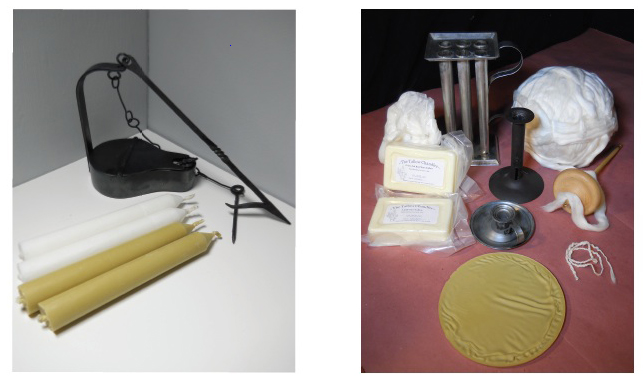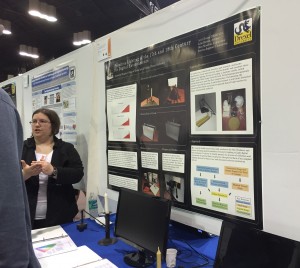ariel
Shining Light on ‘Light in the Past’:
Illumination for Virtual Archaeological Site Reconstructions as an example of Experimental Archaeology

Current research by Ariel Evans is helping make digital reconstructions of the past– including archaeological sites– more accurate. Evans is identifying and virtually recreating the light spectra qualities of bayberry candles, tallow candles, and Betty Lamps fueled by lard. Archaeologists often find evidence of the use of these and other 17th and 18th century lighting devices in historical archaeology sites. (Photos courtesy of A. Evans, adapted from Evans’ poster, “Primitive Lighting of the 17th and 18th Centuries for Digital Environments”, presented at the 2015 Drexel University Research Day.)
Today we can flip a switch and electricity brightens our interior spaces, even turning our nights into longer days. A current research project underway at Drexel University in Philadelphia, Pennsylvania (USA) is pointing out how much we take this control over light for granted as well as how we naively project our experience with modern light quality onto the past when we create reconstructions of the archaeological past. The project in question involves research on lighting using modern reconstructions of historical period lighting devices. The gathered light spectral data is then used in recreating past life experience in virtual, or digital, environments (i.e., online exhibits, computer game platforms, and even cinematography). This research, based in Media Arts technologies, is also an example of Virtual Experimental Archaeology.
Virtual Lighting Research as Experimental Archaeology
Experimental Archaeology (known to some as Reconstruction Archaeology) is a scientific subfield of archaeological study that attempts to replicate, reconstruct, or reproduce either the physical processes of archaeological site mechanics or the social behaviors of ancient peoples using information from found artifacts. Such studies, undertaken in the present, are conducted in order to better understand and interpret the archaeological evidence of the human past. One famous example of Experimental Archaeology is the balsa wood raft known as Kon Tiki that was built and deployed by Thor Heyerdhal to explore the possibility of contact between South America and Polynesia. Other examples involve experiments in flintknapping to confirm stone tool manufacturing techniques and even left- and right-handedness of tool producers who were living in the past.
Ariel Evans, a Media Arts Masters Degree student at Drexel University’s Antoinette Westphal College of Media Arts and Design, is conducting research that falls under the category of Virtual Experimental Archaeology. Evans is researching the quality of illumination typically found in 17th- and 18th-century lighting devices for the needs of presenting the past in digital environments. She is compiling her research results to produce a guide for use in recreating illumination spectral quality (i.e., light levels and qualities) when designing digital environments be it for museum exhibitions, online presentations, computer gaming platforms, or cinematography. Her research results, presented recently in the poster entitled, “Primitive Lighting of the 17th and 18th Century for Digital Environments”, was awarded a 1st-Prize at Drexel University’s 2015 Research Day.

Ariel Evans presenting her research findings on 17th and 18th century lighting device illumination at the 2015 Drexel University Research Day.
As part of her Master’s Degree study, Evans will be applying (i.e., demonstrating) her research findings in an interactive, 3D, digital model being created as part of an on-going, Drexel University-based, Digital Cultural Heritage initiative led by Dr. Glen Muschio and produced by several Drexel University undergraduate and graduate students. The digital model Evans’ work will contribute to reconstructs the James Dexter house site which is an archaeological site that was excavated during construction of the National Constitution Center in Independence National Historical Park (in Philadelphia, Pennsylvania) in 2003. During the 1790’s, a free African American coachman named James Oronoke Dexter lived in the house with his family. The digital model of the Dexter House, enriched with the addition of Evan’s lighting research, can help in interpreting the history of free Blacks living in colonial America. (For more on virtually interpreting the James Dexter archaeological site see Cunanan 2014, Kirk 2013, The Library Company Black Founders web page, Mlodzienski 2015, and Muschio 2014, 2012)
Lighting Devices in Archaeology
Archaeologists working throughout the world occasionally find evidence of lighting devices when excavating archaeological sites. Among those items found in 17th and 18th century historical archaeology sites are wooden and metal molds for creating candles, and metal, glass, and clay lamps that burned any number of fuels including lard, fish, or whale oil, and various vegetable or plant oils. These items are interpreted in various ways when they are encountered, depending on the research design questions being asked of the archaeological site. Among other possibilities, they are considered utilitarian items representative of home life and or workshop labor, as indicators of domestic (homemade) craft behaviors (e.g., rendering candles), and as evidence of economic activity (where oils and lamps are procured as commodities in primary or secondary markets). The particular composition of the lighting device evidence — bees wax, tallow, pewter, etc. — can also be used in inferring economic status to the past inhabitants of the archaeological site producing the lighting-related artifacts. While no lighting devices were discovered during excavation of the Dexter house site, historical records for the period, and archaeological sites dating both to that time period and from nearby areas, have produced ample evidence of the types of lighting devices that would be expected in the Dexter house.
Lighting Devices and Virtual Site Interpretation
Evans’ research, conducted under the direction of Advisor John Berton of Drexel University, involves examining and collecting wavelengths (color) and luminous data (brightness) from different types of candles and lighting devices commonly in use in the Mid-Atlantic region of the U.S. eastern seaboard during the colonial- and Federal-eras. She employs modern but historically accurate lighting devices in determining these historical period light spectrums. Specifically, she has collected spectral data on bayberry candles, tallow candles, and Betty Lamps that were fueled by lard. The resulting data provides a useful resource standard for simulating quality of light in creating digital environments (both virtual computer landscape platforms and cinematography). This work should lead to more historically accurate digital reconstructions of archaeological sites.

(Left) Wavelengths (color) and luminous data (brightness) collected by Ariel Evans from a sample of modern recreated 17th and 18th Century Lighting Devices -a bayberry candle, a tallow candle, and a Betty Lamp fueled by lard. This type of Virtual Experimental Archaeology provides important data for making digital reconstructions of archaeological sites more accurate. Current virtual interpretations of interior archaeological site reconstructions are generally presented with illumination (re lighting quality) typical of today’s modern incandescent and or LED light-bulbs creating a false historical reality. (Chart graphs courtesy of A. Evans, adapted from Evans’ poster, “Primitive Lighting of the 17th and 18th Centuries for Digital Environments”, presented at the 2015 Drexel University Research Day.)
Shining Light Onto Lighting in Presenting the Past
Archaeologists and museum specialists have long used the characteristics of early dating lighting devices to help explain just how different life was in the past. This includes how daily experience took place in darker interior spaces, making for shorter days (during which activities take place), and constraints on the range of indoor activities possible (in comparison to today). Rarely, however — until now, has this quality of light in every day life experience been considered in terms of virtual archaeological site interpretation. Currently, most historical and archaeological sites digitally recreated for use in museum exhibits, online presentations, computer games, and or in cinematography are routinely populated with modern lighting conditions. For example, an avatar walking into a reconstructed virtual room will be, for all intents and purposes, presented as entering a space lighted with the spectral quality of natural daylight or illumination levels we have come to expect from incandescent and now LED light bulbs. When period structures are reconstructed or even reused for cinematographic filming, the ‘set’ is augmented by studio directional and backlit lighting, even when the scene involves a burning hearth, candle, or lamp. In crafting historical period presentations we inadvertently interject modern levels and rates of room illumination and the corresponding level/rates of visibility of objects depicted in virtually recreated interiors. We have unconsciously introduced a major modern characteristic into archaeological site reconstructions that in turn shapes past understandings of historical reality.
While present conditions always shape the understandings and presentations of the past, in this case, this introduced factor of modern levels of illumination has been uncritically and ignorantly produced. At a minimum, such digital reconstructions are fostering anachronistic conceptions of reality (presentations with characteristics out-of-step with time). Evans’ Experimental Archaeology research on the spectra of 17th and 18th century lighting devices, and the application of her research findings to creating virtual (digitally reconstructed) environments, promises to help archaeological site recreations be more true to historical reality.
~~~~~~
This write up, contributed to the Philadelphia Archaeological Forum by Patrice L. Jeppson, Ph.D. (06/01/15) draws upon the following research:
Cunanan, Chester
2014 Archaeological Reconstruction Using the Oculus Rift, Philadelphia, PA. Blog posting for the 2014 International Day of Archaeology Blog Project. http://www.dayofarchaeology.com/archaeological-reconstruction-using-the-oculus-rift-philadelphia-pa/
Evans, Ariel (2015) “Primitive Lighting of the 17th and 18th Century for Digital Environments”. First Place Award Winning Poster, presented at Drexel University Research Day.
Independence National Historical Park
n.d. The James Dexter Site. http://www.nps.gov/inde/learn/historyculture/james-dexter-site.htm
Kirk, Jason
2013 Award Winning, 3D model of the James Dexter House Archaeological Site. Blog posting for the 2013 International Day of Archaeology Blog Project. https://www.phillyarchaeology.net/philly-archaeology/artifactindex/june-2013-artifact-of-the-month/
Mlodzienski, Mathew
2015 “Preserving History: Reconstruction of the James Oronoco Dexter House. Poster Presentation at the 2015 Drexel University Research Day.
Muschio, Glen
2014 Historical Archaeology, New Technologies and Community. Blog posting for the 2014 International Day of Archaeology Blog Project. http://www.dayofarchaeology.com/tag/glen-muschio/
2012 Digital Media Technologies. Blog posting for the 2013 International Day of Archaeology Blog Project. http://www.dayofarchaeology.com/digital-media-technologies/
The Library Company
n.d. Black Founders: The Free Black Community in the Early Republic. http://www.librarycompany.org/blackfounders/section6.htm
by admin